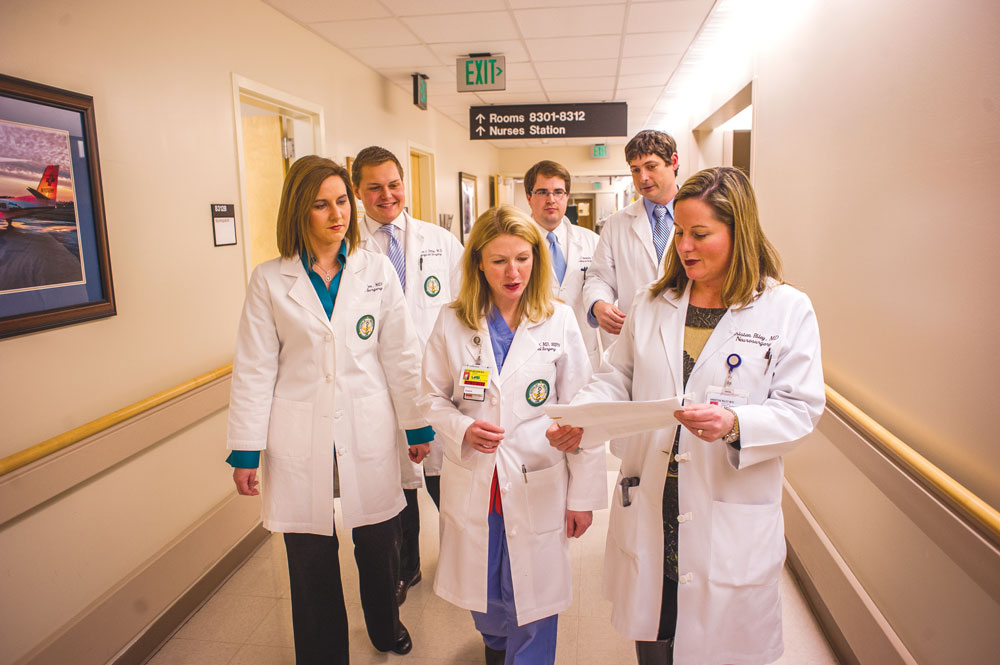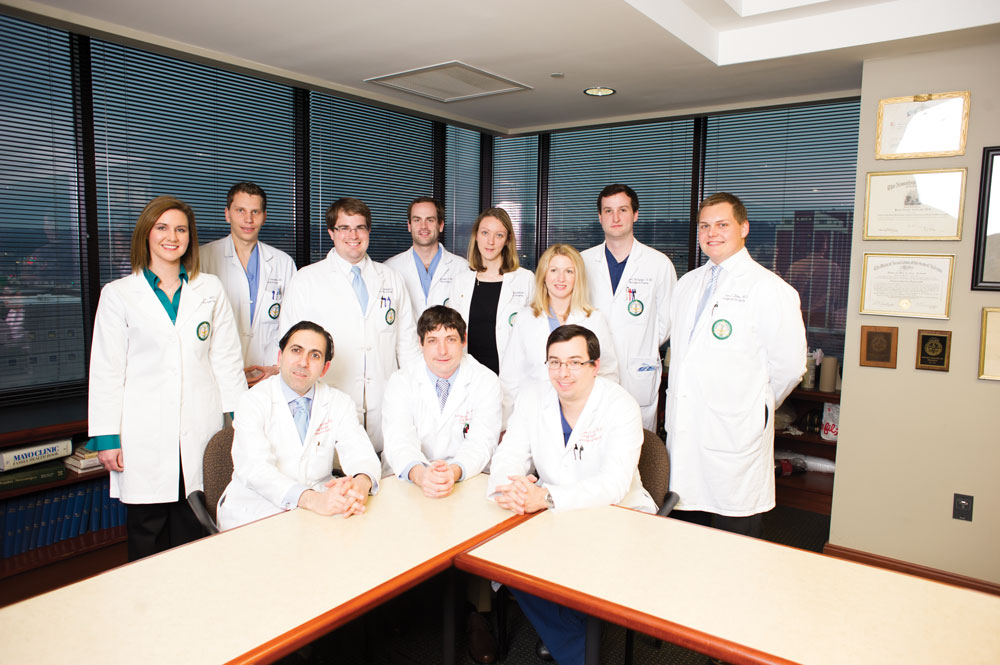Neurosurgery residents often spend 80 hours a week performing operations and patient consults, attending rounds, and answering late-night pages. But last year, the UAB Department of Neurosurgery’s 15 residents also managed to publish 75 articles in peer-reviewed medical journals. Several articles made the magazines’ covers while others were editor’s picks.
 Their outsized publishing success stems from an organized effort within UAB’s Neurosurgical Residency Training Program to teach “evidence-based medicine,” say Mark N. Hadley, M.D., program director, and Beverly C. Walters M.D. M.Sc., director of the division’s Office of Clinical Research. Evidence-based medicine is the practice of using the best current evidence to make decisions on treating an individual patient; while the concept isn’t new, it has gained momentum in recent years, says Walters, who coauthored a book on the topic. “We’re trying to graduate residents who inherently practice evidence-based medicine,” says Walters. “I can’t imagine teaching residents to practice neurosurgery without teaching them to critically evaluate the literature and create good literature of their own.”
Their outsized publishing success stems from an organized effort within UAB’s Neurosurgical Residency Training Program to teach “evidence-based medicine,” say Mark N. Hadley, M.D., program director, and Beverly C. Walters M.D. M.Sc., director of the division’s Office of Clinical Research. Evidence-based medicine is the practice of using the best current evidence to make decisions on treating an individual patient; while the concept isn’t new, it has gained momentum in recent years, says Walters, who coauthored a book on the topic. “We’re trying to graduate residents who inherently practice evidence-based medicine,” says Walters. “I can’t imagine teaching residents to practice neurosurgery without teaching them to critically evaluate the literature and create good literature of their own.”
Discerning Eye
The program began emphasizing evidence-based training in 2009, when Walters, a neurosurgeon and clinical epidemiologist, joined the faculty. At that time, residents published about 11 journal articles. The switch in focus “helps us discern how to value the evidence in a manuscript,” Hadley says. “There’s a very rigid, scientific regimen to go through, depending on whether the article is about a prognosis, diagnostic test, or procedure. I want residents to read and say, ‘that’s a landmark article,’ or ‘this has been highly touted in the press, but there’s no medical evidence for it.’”
Ultimately, says Hadley, evaluating articles teaches residents how to design their own studies and contribute to medical literature. The Office of Clinical Research offers epidemiology, biostatistics, and clinical trials expertise to help residents win grants, conduct projects, learn to create databases and statistical analyses, and disseminate results. Every resident is required to publish at least one article a year, says Walters, but they’re encouraged to aim for three each year. Residents also participate in a monthly journal club and medical evidence conference.
About 90 percent of resident articles eventually publish, Walters says. “If the first journal refuses it, we keep going.” Some residents also have presented research and earned recognition at regional and national conferences.
 From Problems to Solutions
From Problems to Solutions
Some of the most prolific writers, including fifth-year resident Christoph Griessenauer, M.D., have each published an average of 10 to 15 papers a year. Research keeps the field interesting by advancing knowledge, says Griessenauer, whose focus includes cerebral vascular surgery. “We take a problem in clinical practice and see if we can find a solution.”
The training has helped residents pursue fellowships, subspecialty training, and academic careers, says Hadley. “I’m proud of them for taking on a more focused study that is a bit more onerous,” says Hadley, “and then applying it and earning recognition for themselves and UAB by publishing and contributing.”
Neurosurgery residents now have the opportunity to become Clinical Research Scholars thanks to the Neurosurgery Women’s Leadership Council—a group of former patients and family members. The first award benefits a student this fall, says Jacquelyn S. Shaia, J.D., Ph.D., a UAB communications studies instructor who first received treatment from UAB neurosurgeons a decade ago. A common interest and “common love” for the neurosurgery program brought the women together, says Shaia. The organization has begun raising support for an endowment for the scholars program and current-use funds to meet immediate needs. “The residents are at the top of their game,” says Shaia, “They’ve got the interest, good mentors, good leadership, and are learning skills to be successful. It is our job, as people who have benefited from this wonderful medicine, to help put this neurosurgery program on the map in a more permanent way.”